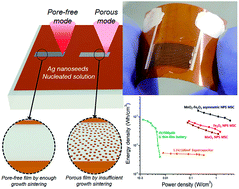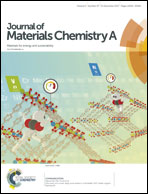High-energy, flexible micro-supercapacitors by one-step laser fabrication of a self-generated nanoporous metal/oxide electrode†
Abstract
A high-performance and flexible micro-supercapacitor based on a self-generated nanoporous silver layer was fabricated by a one-step laser-induced growth-sintering process of a particle-free organometallic solution. The porous structures self-generated on a polymer film and were freely adjustable by controlling the rate of laser input dose. By changing the patterning mode, the nanoporous electrodes with extremely high surface area and highly conductive current collectors were formed in a single processing domain. Electrodeposition of hetero metal oxides (manganese and iron oxides) as the active materials followed, and a flexible micro-supercapacitor with high volumetric energy density of 16.3 mW h cm−3 and power density of 3.54 W cm−3 was formed. This was achieved through the large surface area and high electrical conductivity of the nanoporous silver layer, and high operating voltage due to the asymmetrical electrode configuration. This method resulted in a faster and more cost-effective manufacturing process than conventional MSCs fabrication. It also achieved the highest volumetric energy density in metal/oxide-based MSCs as a state-of-the-art performance.



 Please wait while we load your content...
Please wait while we load your content...